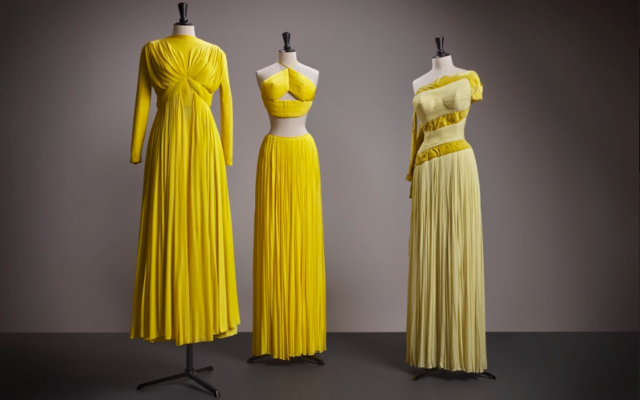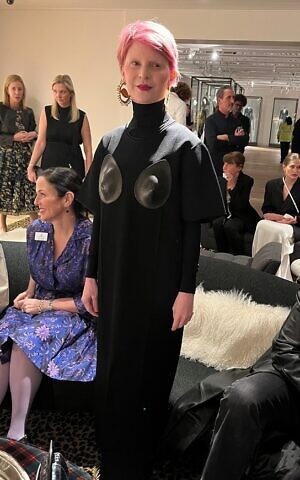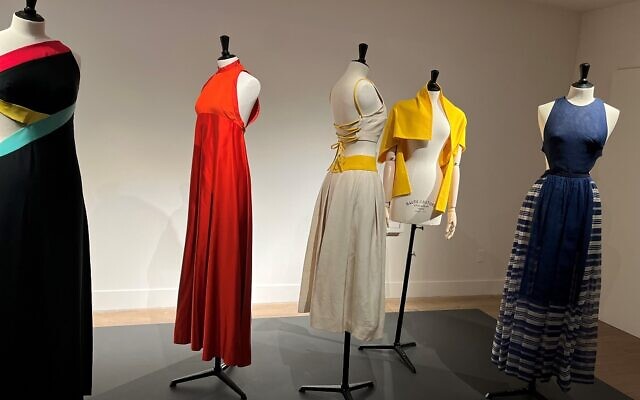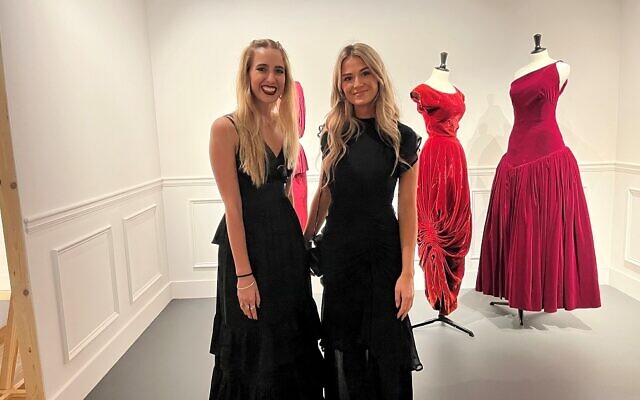Haute Couture Resurfaces with Jewish Madame Grès
In a Nov. 10 preview party, SCAD FASH told the glamorous and mysterious story of the most famous “Hellenistic” designer.
After 37 years with the Atlanta Journal-Constitution and now with the AJT, , Jaffe’s focus is lifestyle, art, dining, fashion, and community events with emphasis on Jewish movers and shakers.
On Nov. 10, Savannah College of Art & Design (SCAD) FASH Museum of Fashion + Film premiered the work of Madame Grès (b. Germaine Émilie Krebs in Paris, France) in the first retrospective of her work in the U.S. in 15 years.
Beginning her career using the alias, Alix, in the 1930s, Germaine Émilie Krebs was a leading French couturier, costumer designer, and founder of the esteemed fashion house, Grès. Evoking the style of ancient Greece, her gowns were aesthetic and constructional feats that relied on layered and folded precision. Her fashions were worn by Grace Kelly, Paloma Picasso, Greta Garbo, Wallis Simpson, and Jacqueline Kennedy. The “Jewish back story” unfolds with her defiance of the Nazis.
Madame Grès originally aspired to become a sculptor. Finding solace in her atelier, she became the greatest sculptor of the designers of her era. A contemporary of Madeleine Vionnet, Coco Chanel, and Elsa Schiaparelli, Madame Grès was revered for her expert use of draping and innovative construction in garments evoking the sensual style of ancient Greece. Her creations have inspired many illustrious designers including Cristóbal Balenciaga, Ralph Rucci, Issey Miyake, and Isabel Toledo.

Grès was born into a middle-class Jewish family. Not much is known about her personal life which she strove to keep secret. What is known is that she was a perfectionist who originally studied sculpture and hat making, which pivoted well into her fashion line. She married Russian painter Serge Czerfkov and had one daughter, Ann, who was equally mysterious by keeping her mother’s death a secret for one year.
Grès was not known for easy working conditions. She was said to have made apprentices work in silence, akin to a convent, without natural light, and sit on certain stools versus chairs, based on experience, perhaps after 10 years. She used live mannequins and took up to 300 hours to construct one dress. She was also known for her perfume, Cabochard, or “stubborn.”

Her ferocity was demonsrated during the German occupation of France in World War II, when she defied orders from the occupation government to design bare, utilitarian clothing for the wives of German officers, yet continued to design luxurious gowns in the colors of the French tricolor flag.
Stubborn Grès designed gowns that had Stars of David sewn inside. Eventually, she was shut down on the pretense that she was using too much fabric during wartime. She resurfaced as Madame Grès, eventually lost everything, and was supported by top designers Givenchy, Yves Saint Laurent and Pierre Cardin in her last years.
The word “gres” is an anagram of her husband’s name, Serge. The company was eventually sold to a Japanese firm.
SCAD FASH worked with the Fondation Azzedine Alaïa, Paris, to bring this representative selection of her work to the U.S., approximately 65-70 garments. The Fondation houses a collection of garments personally collected by the Tunisian designer Azzedine Alaïa and is an important resource for fashion historians and students.

The Art of Draping exhibition offers a detailed study of Madame Grès’ evening and day gowns, tailored ensembles, and cocktail dresses, cleverly staged as if in an intimate theater, revealing the meticulous skill of her draping and timeless nature of her creations. The exhibition also features a selection of never before-seen vintage prints on loan from Fondation Azzedine Alaïa and rare images of Madame Grès, taken by the iconic photographer, Horst P. Horst, an artist of her era whose career was intertwined with her own, presented courtesy of the Horst Estate. An exhibition of complementary historical significance, Horst P. Horst: Essence of the Times, is also on view in SCAD FASH’s adjacent display area. The exhibit continues until June 2023. SCAD is located at 1600 Peachtree St., across from The Temple.
- STYLE Magazine
- fashion
- Marcia Caller Jaffe
- Savannah College of Art & Design
- FASH Museum of Fashion + Film
- Germaine Émilie Krebs
- Madame Grès
- ancient Greece
- Grace Kelly
- Paloma Picasso
- Greta Garbo
- Wallis Simpson
- and Jacqueline Kennedy
- Madeleine Vionnet
- Coco Chanel
- Elsa Schiaparelli
- Cristóbal Balenciaga
- Ralph Rucci
- Issey Miyake
- Isabel Toledo
- Serge Czerfkov
- Cabochard
- World War II
- Stars of David
- Givenchy
- Yves Saint Laurent
- Fondation Azzedine Alaïa
- The Art of Draping
- Horst P. Horst
- The Temple




comments